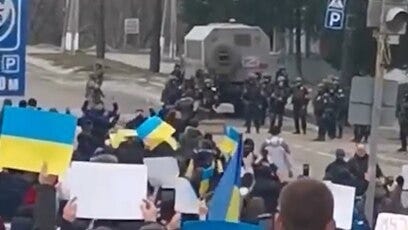Occupation
When a foreign armed force invades the sovereign territory of another country, the most important strategic goal of the defending army is to avoid and prevent occupation of its territory and citizens at all costs. If that is not possible and there is time, the state authorities must evacuate civilians beforehand in territories where the threat of invasion is imminent, as was the case with Ukrainian civilians living in areas close to the front, and near Kupyansk.
Why? In the case of the Russian forces, the Ukrainian population in occupied territories are subjected to forced deportation, torture, rape, looting, and a series of other psychologically and physically violent measures. The Russian occupation forces have followed the same tactics and actions since the inception of the Red Army in 1917, and in the Second World War in Central and Eastern Europe as it invaded Poland, Bulgaria, and the Baltic states. [1]
The first action of the Soviets and now Russian forces is to decapitate all local leadership, and civilians who are important in the territory. Kill lists are real. The Russians do this so there can be no resistance forces. All other practices are designed to enstate fear and terror in the civilian population, and then move on to emptying the local area of Ukrainian civilians as quickly as possible. Hence, they are forcibly deported to the far east of Russia almost never to be heard of again. Once that is complete (or almost), Russian citizens are brought in to replace them, as we are seeing in Mariupol and other Russian occupied territories, and Crimea after 2014. [2]
This is why the Ukrainian government, leaders of Ukrainian civil society, and normal Ukrainian citizens continue to make appeals to their Allied partners to provide the necessary armaments and means so that the Ukrainian forces avoid ceding further territory, and liberate as quickly as possible the territory that is under Russian occupation. This is why Ukrainians fled their homeland in the first few months of 2022: they knew what awaited them had Ukraine fallen under Russian rule. It’s not a question of losing territory to the Russians: it’s a question of saving Ukrainian lives—the lives of their families.
After Bucha, what you can see in the video below has been widely practiced. We saw videos of Ukrainian soldiers and citizens rounded up and brought to gardens to be shot. As one analyst told me, these actions and other violent measures are not carried out by mindless ideologically driven troops: they are normal men.
Tetiana Denford: “A camera was found in an abandoned BMP belonging to Russians fleeing Ukrainian forces in Chernihiv Oblast. On it were photos of a family from a Ukrainian village that had been held by the Russians for a month, and there were also photos of the Russian military themselves. Yes, you read that right, the occupiers were taking pictures with the cameras they had stolen from the locals.”
Transcription Posted by Vlad: "... captured people. A whole month the russian military tortured the people without water and food and in cold basements."
Living under occupation by a foreign force is something that we simply cannot fathom, not having lived through it in the past. The ones who have are most vociferous in calling our leaders to stop wasting time and to increase lethal aid to Ukraine. They are also warning us that we need to build our resilience and offensive and defensive capacities: we are actually very late.
The war in Ukraine had been planned in 2003 according to sources. Russian agents began recruiting Ukrainians and other nationals for training in Russian camps to form brigades for a future invasion. It is conceivable that the current war against Ukraine is simply the first step Putin and the Russian leadership will take in a war of expansion that could compromise Europe. In complete contrast with our way of thinking, the Russians think in the long-term.
The video is horrific in itself, and it’s a reminder that the Russian forces have not stopped their criminal activity—genocide—in the occupied territories of Ukraine. There is no question of ‘negotiation’ with the Russian leadership because every single Ukrainian knows what they will be subjected to: this kind of talk is coming from pundits and neo-realists in the West, or those who wish to restart business practices with Russia as quickly as possible.
It’s up to us to put pressure on our leaders to ensure that Ukraine is provided with the materials, armaments, and ammunition to liberate their people—our European citizens.
Bibliography
[1] There is a rich literature on the practices of Soviet occupation forces. You can begin with a general introduction: Paul Johnson, Modern Times: The World From the Twenties to the Nineties (New York: 1991), Ch 8, 10, 11, 12.
[2] Otto C. Fiala, ROC: Resistance Operating Concept (Florida: 2020).





